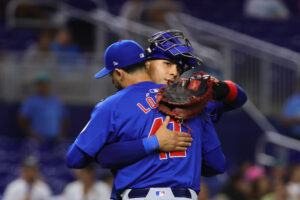(GPP stats collected up to 9/15/21)
On to the hurlers! The 2021 Boston Red Sox staff as a whole was up and down throughout the season. The starting staff went most of the way without ace Chris Sale. In Sale’s absence, Nathan Eovaldi took the mantle and proved to be a worthy placeholder atop the rotation.
Each starter including Eduardo Rodriguez, Nick Pivetta, and Garrett Richards all had their moments of brilliance this season, but in that same token, they also had rough patches. So, with that said how do these individual performances translate to Foolish Bailey’s new stat, good piece of pitching (GPP)?
What is GPP?
Just like GPH, GPP aims to identify pitcher effectiveness in a simple, concise way. GPP measures how many batters faced results in soft contact (contact under 80 mph) or a strikeout. One of the positives for this stat is that it rewards pitchers who induce soft contact. Most of the time high strikeout-rate pitchers are glorified (i.e. Jacob deGrom) and pitchers who pitch to contact (i.e. Lance Lynn) are marginalized.
Weaknesses
Yes, GPP gives some love to contact pitchers but it (just like any other stat) has a weakness or two. One of them is that there is no consideration for defense. Contact pitchers rely heavily on strong defense behind them. GPP, much like FIP, focuses solely on the pitcher’s performance. So, if a pitcher has a low strikeout rate, his total GPP could suffer even though he may still be pitching effectively to contact.
2021 Red Sox Starters and GPP
We are going to divide the pitching staff up by starters and relievers. For starters, Eduardo Rodriguez leads the way. More so than anything, Rodriguez’s ability to cause soft contact has allowed him to pose a high GPP percentage. We’ll come back to Rodriguez in a second.
Starters
| Player | Total Batters Faced | Soft Hits | Soft Hit % | K’s | K% | GPP | GPP% | GPP % MLB Percentile Rank |
| Eduardo Rodriguez | 609 | 129 | 21.3% | 165 | 27.2% | 294 | 48.4% | 92 |
| Tanner Houck | 225 | 42 | 18.8% | 63 | 28.3% | 105 | 47.1% | 89 |
| Nathan Eovaldi | 701 | 128 | 18.3% | 180 | 25.8% | 308 | 44.1% | 74 |
| Nick Pivetta | 601 | 82 | 13.7% | 156 | 26.1% | 238 | 39.8% | 45 |
| Martin Perez | 482 | 91 | 19% | 92 | 18.2% | 183 | 38.2% | 34 |
| Garrett Richards | 576 | 81 | 14.1% | 108 | 18.8% | 189 | 32.8% | 7 |
One person that is conspicuous by his absence is Sale. Sale didn’t quite make the qualifying 200 batters faced by September 15 (when this data was collected). If Sale was added to this list, he would be first with a 52.3 GPP percentage. This would be 12th overall in the majors.
Chris Sale GPP Stats (through September 15)
| Total Batters Faced | Soft Hit | Soft Hit % | K’s | K% | GPP | GPP% |
| 109 | 27 | 24.8% | 30 | 27.5% | 57 | 52.3% |
E Rod & GPP
Now back to Rodriguez. He’s an interesting case because his pitching profile isn’t very impressive. Few would expect someone with a 4.74 ERA and a .363 BABIP to be amongst the best when it comes to a pitching category. But GPP helps to highlight his strengths and elevate his profile as an effective pitcher.
His percentile rank puts him among notable starters such as Gerrit Cole and Carlos Rodon. Another point that points to Rodriguez being a bit more effective than his standard stats show is the difference between his ERA and his FIP. His 1.42 difference supports that he ran into some bad luck. His ERA this season was a career-high as well as his ERA/FIP differential. Going forward, based on his history, his numbers should correct itself. His average ERA over the last two seasons has been 3.81.
Even when using a stat like SIERA, it still supports Rodriguez being better than his ERA states. SIERA quantifies a pitcher’s performance by trying to eliminate factors the pitcher can’t control by himself (much like FIP). The difference is that SIERA takes balls in play into account, so a pitcher like Rodriguez, who forces a lot of ground balls, will have a low SIERA. Rodriguez had a .365 SIERA this regular season. That would put him between great and above average on the SIERA scale.
With a viable defense behind him, Rodriguez has proven that he is a dependable option as a bottom of the rotation starter. With him being an unrestricted free agent this off-season, GPP might help him elevate his status as he negotiates.
Eduardo Rodriguez 2021 Regular Season Pitching Profile

Counting vs Rate
The graph that was used was again sorted by GPH percentage. But, the question is whether GPP would be more effective as a rate stat or a counting stat. We see that when we look at GPP percentage, Eduardo Rodriguez ranks first among Red Sox starters, but if we look at the total volume on how many times they’ve struck out a batter or coaxed soft contact, Eovaldi takes the reigns as number one.
Overall, a look at the leaderboards for GPP% will get a mix of more relievers, since they don’t have as much of a workload as a starter. Looking at the GPP volume leaderboard will show some of the names who have been amongst the elite this year, such as Cole, Wheeler, Burnes, and de Grom.
Bringing this back to the Red Sox, those who have watched at all this season would be pretty hard-pressed to find anyone who disagrees that Eovaldi has been the club’s best starter this year. So the fact that Eovaldi is the leader in Red Sox GPP volume supports the fact that GPP is better as a counting stat.
Main Photo:
Players mentioned:
Chris Sale, Nathan Eovaldi, Eduardo Rodriguez, Nick Pivetta, Garrett Richards, Jacob deGrom, Lance Lynn, Tanner Houck, Martin Perez, Gerrit Cole, Carlos Rodon






